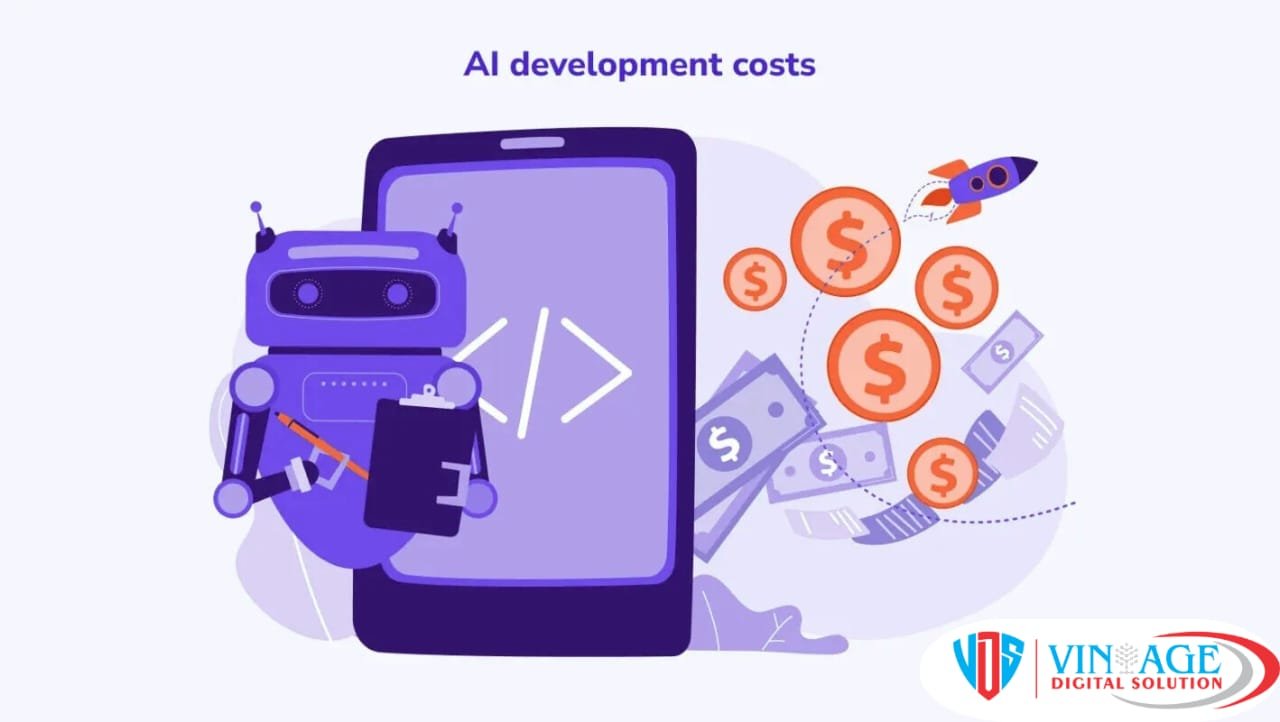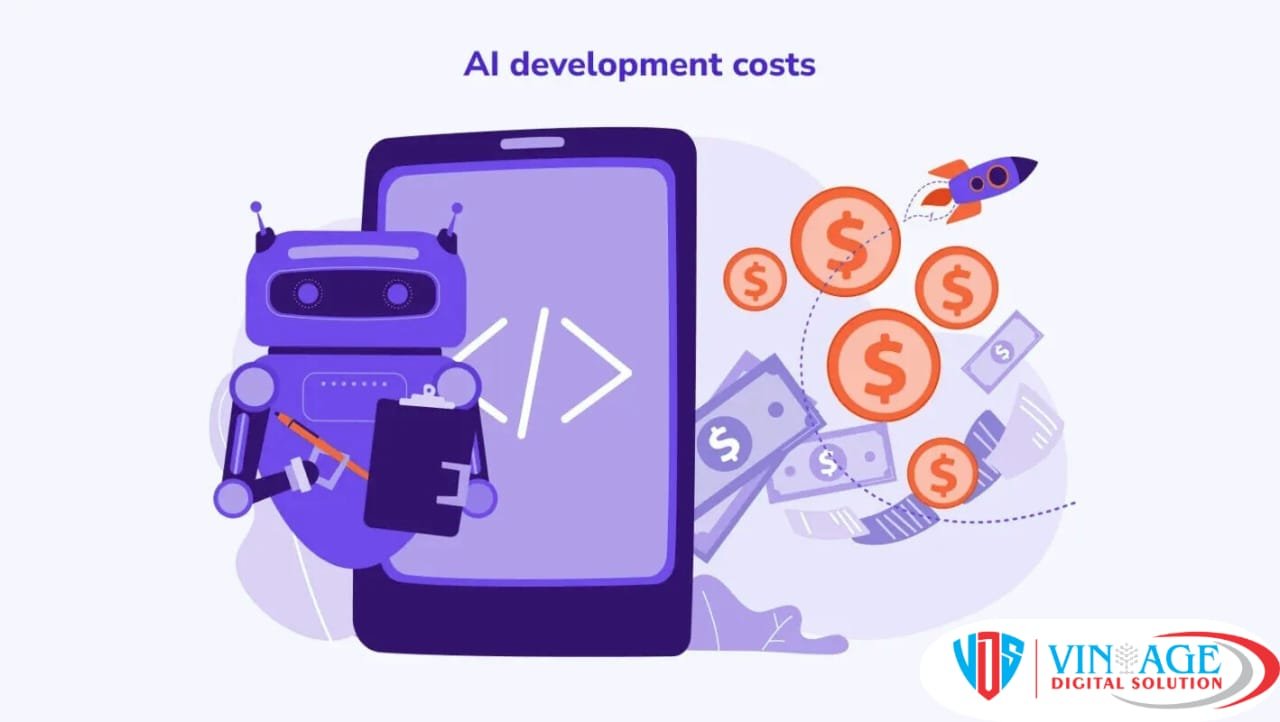
The adoption is accelerating, but what about the required investments? AI remains a black box for many decision-makers because its opportunities seem almost unlimited, while the required budget for implementation remains unclear. In 2025 and beyond, understanding the cost of developing and implementing AI is no longer optional. It’s a key part of business planning, risk management, and ROI forecasting.
This article offers our accumulated knowledge on the costs of building AI solutions. We at Vintage Digital Solution have developed multiple custom Artificial Intelligence solutions and provided Open AI development services to businesses across 27 countries. This article reflects what we’ve learned from this.
AI Development Cost at a Glance
First, let’s briefly answer one question: how much does AI cost?
Just as with other software solutions, multiple factors affect the overall development costs of AI solutions. However, there is a superior factor: project complexity, which splits all software solutions, including one with AI, into 4 groups.
| Complexity level | Example projects | Estimated cost range (USD) | Development time |
|---|---|---|---|
| Simple | Rule-based chatbot, form auto-fill, AI FAQ assistant | $5,000 – $50,000 | 1–2 months |
| Moderate | ML-based recommendation engine, customer sentiment analysis | $50,000 – $150,000 | 2–4 months |
| Advanced | Computer vision, predictive maintenance, NLP-driven assistant | $150,000 – $400,000 | 4–6 months |
| Enterprise/Complex | LLM-powered app, real-time AI for fintech or healthcare | $400,000 – $1,000,000+ | 6–12+ months |
In-house – the company hires specialists in-house, managing them and handling all aspects of development and operations. This model offers the highest control, but is also the most expensive.
Outsourced – the business partners with an external software development provider and fully outsources the process of AI development and implementation. This model is cost-efficient and fast to start, but lacks control over the flow and implies risks of finding an unreliable vendor.
Hybrid – this one is the mix of the previous two models. The company keeps key roles in-house, usually a project manager or tech lead, and collaborates with an external team for development and support. This model combines the control benefits of in-house development and the cost-efficiency of the outsourcing model.
Model Fine-Tuning & Retraining
AI models degrade over time as data changes. Regular fine-tuning or retraining is needed to maintain accuracy, especially for customer behavior, fraud, or operational models. A good practice here is to run major retraining and fine-tuning 1-2 times a year.
Estimated costs: ~5–10% of initial dev cost annually.
Infrastructure Scaling
As we’ve already mentioned, the growing number of users implies the need for growing infrastructure, compute capabilities, storage, GPU power, etc. This cost applies to all infrastructure types: cloud, on-premise, and hybrid.
Estimated costs: ~5–15% of initial dev cost annually depending on volume and infrastructure type.
AI Model Monitoring & Debugging
This AI development cost aspect is unique to AI systems, and it’s about monitoring the AI model’s behaviour and health. AI developers track model accuracy, latency, and performance, detecting drift of model degradation, alerting when behaviour anomalies happen, debugging misclassifications and hallucinations, and logging performance metrics.
Estimated costs: ~3–5% of initial dev cost annually (for tools + minimal engineering time.
Regulatory Changes
(especially in healthcare/finance)
This additional aspect is especially acute for highly regulated industries like healthcare or finance. Compliance updates may require retraining the model or rebuilding parts of the system. These costs can be unpredictable and significant.
Estimated costs: ~2–15% of the initial dev cost a year when regulatory requirements change. The exact cost depends on the industry and regulatory impact.
Post-Deployment Support & Updates
These are usually maintenance costs that are relevant to all software solutions. They include bug fixes not related to the AI model, performance optimizations, technology updates, security patches, minor feature enhancements, and UI tweaks after the launch.
Estimated costs: 2–5% of initial dev cost annually
Total Ongoing and Hidden Costs Estimate
Likely around 17–30% of your initial AI development cost per year, with up to 50% in the worst-case scenario. Regulatory changes are the most unpredictable, but still should be considered. The latest report on the AI index from Stanford University identified that the number of AI-related regulations in the United States doubled in 2024 compared to 2023.
AI Development Cost Without a Clear Purpose and Goal
We have repeatedly received leads with brilliant ideas for using AI that ultimately never reached the development stage. The reason is simple: these ideas lacked an understanding of why AI was needed and what it would achieve.
This issue isn’t limited to startups with innovative ideas. Businesses approach us with requests like “We want to integrate AI into our business to increase efficiency,” without specifying what efficiency means, where AI should be applied, or why they concluded that AI is necessary.


6 Comments on “ How Much Does AI Development Cost in 2025? A Complete Breakdown”
-
Kajal
20 May, 2025This Article is very help full.
-
sudha
17 May, 2025nice
-
Radhika
17 May, 2025helpful
-
Reena Pandey
17 May, 2025This article is to the point
-
Reena Pandey
17 May, 2025This article is to the point
-
Akash goyal
17 May, 2025Very helpful

Leave a Reply